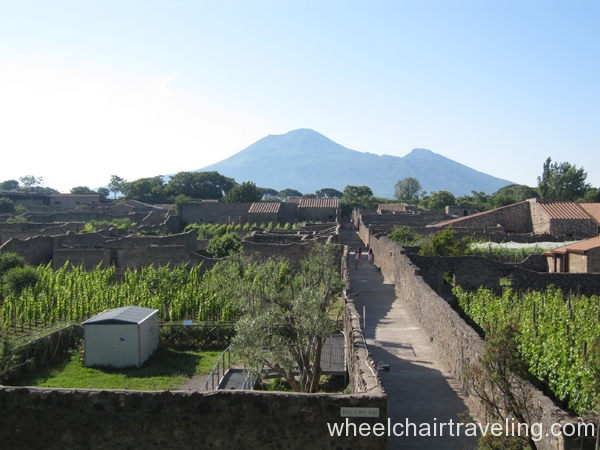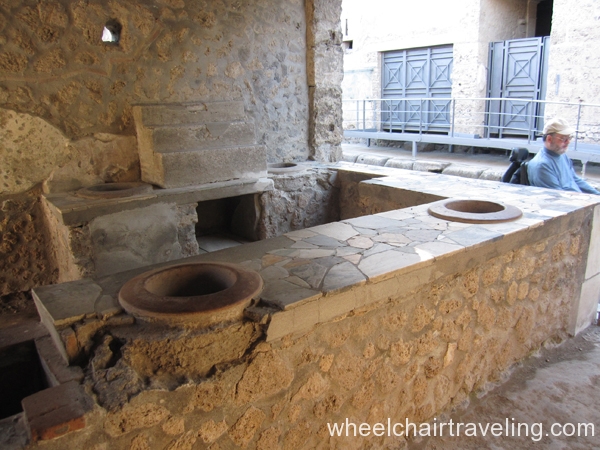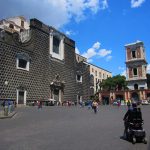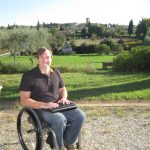Because one’s capabilities, limitations, and equipment affect the access achievable and his point of reference informs his perceptions, we’ll tell you about ourselves. Howard has fsh muscular dystrophy, uses a power wheelchair, and cannot stand or walk. Michele is able-bodied. On our trip Howard used his everyday wheelchair, a Permobil with a seat elevator, reclining back, elevating footrest, and tilt-in-space. The Permobil is comfortable and rugged. It weighs around 325 pounds (148 kg) and cannot be lifted, but it can climb a curb or step around 3 inches (7 to 8 cm) high. The Permobil is 26 inches (66 cm) wide and, with the footrest in the shortened position, 48 inches (1.22 meters) long.
Getting to Pompeii from Naples
We went to Pompeii in 2012 and were fortunate to get accessible transportation from friends.
The description of the train that follows is based on our 2006 trip to Naples, but we didn’t get to Pompeii at that time. The ride from Naples to Pompeii takes half an hour on the Circumvesuviana, a train line operated by EAV (Ente Autonomo Volturno), a different entity from Trenitalia, the Italian national train company. There is a Circumvesuviana station in Naples at Porta Nolana, a few blocks from the Naples central train station, Napoli Centrale (located at Piazza Garibaldi). There is also a Circumvesuviana station at Napoli Centrale but we don’t know whether it’s accessible. At Porta Nolana station there is a large, modern elevator down to the platform; the elevator is through a locked gate, so you must ask an employee to open the gate. The trains were level with the platform, but there was a horizontal gap of around three inches. To get to the excavations in Pompeii, take the Circumvesuviana toward Poggiomarino and get off at Pompeii. The same line, in the same direction, goes to the excavations (scavi in Italian) at Herculaneum; we don’t know whether the station there is accessible.
We didn’t go to Pompeii in 2006: we got a late start, realized that if we went to Pompeii we’d be returning at night, and didn’t feel comfortable returning to the Porta Nolana Circumvesuviana station in Naples at night because the area was very seedy. In 2014 the Naples central train station area was greatly cleaned up from previous trips, so it is quite likely that the area around Porta Nolana has also improved.
EAV Phone: Circumvesuviana – (011-39) 081-772-2254. Porta Nolana station – (011-39) 081-772-2259. Green toll-free phone (from within Italy only): 800-211-388. The website does not have information about wheelchair access.
Pompeii
We went to Pompeii in June 2012. There is an ongoing major project to make parts of the archaeological site wheelchair accessible, creating an accessible route called Friendly Pompeii. Although only a fraction of the site is accessible, a visit is worthwhile. Allow two to three hours to see the accessible areas. Because of the heat and sun, a late afternoon visit is advisable; at that time the antiquities are beautifully illuminated by dazzling sunlight but it’s not overwhelmingly hot. Many of the surfaces are dirt, gravel, and rock. They can become muddy after rain, so avoid going after it’s rained.
There are three entrances to the excavations; the entrance at Piazza Anfiteatro (amphitheater) is the most wheelchair accessible. (We were told that the entrance at Piazza Anfiteatro is a few minutes’ walking distance from the Circumvesuviana train station in the center of the modern city of Pompeii.)
The Friendly Pompei route begins at the amphitheater, which has a separate entrance from the rest of the site. There we started. The paths into the amphitheater are somewhat steep and bumpy, but not difficult for most electric wheelchairs and scooters. Manual wheelchair users would need assistance. The amphitheater seats aren’t open to the public; one visits the ground level, where gladiators and animals fought, and executions took place. The ground is flat and composed of hard dirt; it’s easy in a wheelchair.
After visiting the amphitheater we entered the main site via a nearby entrance. Inside that entrance is a medium size accessible restroom. A fairly smooth and flat pathway of brick and dirt leads alongside the vineyards to one of the main streets. (The vineyards have been replanted with the same grape varietals as in the first century AD when Pompeii and environs were major wine production centers. Archaeologists led by Wilhelmina Jashemski identified those varietals by making plaster casts of negative spaces, similar to how the bodies of people killed in the 79 AD eruption of Vesuvius were discovered, and comparing them to the roots of modern varietals.) The street isn’t steep, but its surface of dirt, gravel, and rock is quite uneven. It was not difficult in Howard’s Permobil; manual wheelchair users would need assistance.
That street leads to another flat main street, with hard sidewalks on each side made mostly of concrete and stone, but in some places, there are gaps filled with dirt that make for a bumpy ride. The sidewalks are wide enough for a wheelchair, and from the sidewalk, one can enter a few buildings and see many others from the outside. The street is around a foot below the sidewalk and is made of huge, uneven stones with dirt between them that would be very difficult to navigate in either a manual or electric wheelchair. At several places, there are heavy-duty, wide, well-constructed metal ramps from the sidewalk down to the street, but Howard didn’t try them because the street is so uneven. Some of the ramps lead to entrances to large buildings that were closed for reconstruction when we were there.
Howard waited on the sidewalk in this area while Michele visited the Forum, which is far away, at the other end of ancient Pompeii. The Forum is flat and much of the surface is compacted dirt, but there isn’t an accessible path of travel to it from where Howard waited. It may be possible to visit the Forum in a wheelchair by coming from the other direction, but it’s essential to inquire in advance before attempting this.
We were informed that the Domus of Giulio Polibio (House of Julius Polybius) is wheelchair accessible, but is open to wheelchair users on Saturdays and Sundays only, and a reservation is required. We did not make it there.
We were informed that the Domus of Casti Amanti and the Terme Suburbane aren’t accessible.
The conditions of the entire site change frequently – after all, Pompeii has been excavated and reconstructed for well over 200 years, and the work is still ongoing. Wheelchair access conditions are also changing, generally for the better. The bottom line is that it is worthwhile to go there regardless of how much is open to visitors in wheelchairs at a given time, and it’s also advisable to inquire in advance about the state of access.
More Information:
- Pompeii, Herculaneum, Stabia and Oplontis
- Access information in English
- Phone: (011-39) 081-857-5341 or 081-857-5347 or 081-857-5111 or 081-857-5220.
- Phone for access information: (011-39) 06-39-96-78-50.
Herculaneum
The Circumvesuviana train goes to Herculaneum from Naples, which takes around 20 minutes. We’ve never made it to Herculaneum, but have heard that a wheelchair accessible route has been developed in the past several years.
Archaeological Museum in Naples (Museo Archeologico Nazionale)
Extraordinary artifacts from Pompeii, Herculaneum, and other antiquities sites – mosaics, frescoes, marble, and bronze sculptures (including the Farnese collection of colossal Roman marble statues), glass, and coins – are on display. It’s awe-inspiring to visit the sites and the museum. For historical reasons and preservation purposes, some of the works on display in Pompeii are copies; the originals are in the museum.
Access is excellent. We got there by strolling uphill on via Toledo. The curb ramp at the intersection of via Toledo and Piazza Museo Nazionale in front of the museum is rutted and has a steep cross slope, but Howard was able to navigate it. Many people in manual wheelchairs would need some help. There is a gate at the parking lot near the entrance; get the guard’s attention and he will open it. The building is on a hill but the site is flat. There are no stairs at the entrance. A huge elevator serves all floors. There are no changes in level among the galleries on each floor. Don’t miss the Secret Cabinet, a collection of strange, erotic, and pornographic objects from Pompeii and Herculaneum; visitors must be 14 or older.
In 2014 some of the galleries were closed, not for renovation or installation of exhibits but because the museum was short-staffed due to budget cuts. The closures rotate frequently, so if your heart is set on visiting a particular gallery, inquire in advance to confirm it will be open.
There is a large accessible bathroom on the ground floor, with a large, high toilet; plenty of side transfer space, a large sink, and an emergency alarm cord. The door is a heavy sliding door, so most wheelchair users will require assistance. The bathroom is locked; you must ask an employee for the key. It’s a minor inconvenience to find an employee but this is outweighed by the fact that, like many locked accessible bathrooms in Italy, this one is very clean.
There isn’t a café or restaurant at the museum and the area nearby doesn’t have many restaurants, so it’s advisable to eat lunch somewhere else before or after your visit.
Archaeological Museum website.
Great Courses Lectures
The Great Courses (formerly The Teaching Company) produces lectures on a variety of subjects by award-winning college professors. The lectures are fascinating, in-depth, and visually rich. The following series greatly enhanced our knowledge and appreciation of Pompeii, Naples, and its environs.
- Classical Archaeology of Ancient Greece and Rome by Professor John Hale
- Pompeii: Daily Life in an Ancient Roman City by Professor Steven Tuck




























